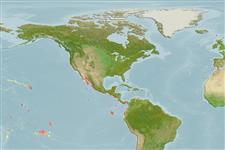>
Gobiiformes (Gobies) >
Microdesmidae (Wormfishes) > Ptereleotrinae
Etymology: Ptereleotris: Greek, pteron = wing, fin + The name of a Nile fish, eleotris (Ref. 45335); carinata: Name from Latin 'carina' for keel, 'carinata' meaning keeled; referring to the distinct membranous keel extending beneath the head..
Environment: milieu / climate zone / depth range / distribution range
Ecologia
marino demersale; distribuzione batimetrica 12 - 25 m (Ref. 75966). Tropical
Eastern Pacific: Mexico (Gulf of California), Costa Rica and Panama.
Size / Peso / Age
Maturity: Lm ? range ? - ? cm
Max length : 8.3 cm SL maschio/sesso non determinato; (Ref. 75996)
Short description
Morfologia | Morfometria
Spine dorsali (totale): 7; Raggi dorsali molli (totale): 20-22; Spine anali 1; Raggi anali molli: 20 - 23. This species is distinguished from its congeners by the following characters: a short dorsal-fin (VI-I,20-22), first and second dorsal fins of about equal height; short anal-fin (I,19-22);isthmus with a conspicuous median fold or keel; caudal fin lanceolate with a dusky band on lower caudal rays in adults; a blue or lavender body without other markings (Ref. 75966).
The western Atlantic form, Ptereleotris calliurus, is similar to P. carinata in its more lanceolate tail with dark lower half, but differs from P. carinata in having a variety of other fin markings (vs. absent).
Individuals were seen poised 10-20 cm above small mounds encircling the small openings to their burrows. It was also observed in burrows always close to a reef or grouped in small colonies on gently sloping mud-sand bottoms usually hundreds of meters from any rocky substrata. Juveniles were collected with quinaldine from the same burrows as adults they darted into. Often two adults or an adult and one or two juveniles were seen to occupy the same burrow. Individuals when prevented from entering their own burrow, would sometimes swim away rather than enter neighboring burrows (Ref. 75966).
Life cycle and mating behavior
Maturità | Riproduzione | Deposizione | Uova | Fecundity | Larve
Bussing, W.A., 2001. Ptereleotris carinata, a new species of hovering goby (Perciformes: Microdesmidae) from the tropical eastern Pacific. Rev. Biol. Trop. 49(Supl. 1):133-139,. (Ref. 75996)
IUCN Red List Status (Ref. 130435)
Threat to humans
Harmless
Human uses
Informazioni ulteriori
Nomi ComuniSinonimiMetabolismoPredatoriEcotossicologiaRiproduzioneMaturitàDeposizioneSpawning aggregationFecundityUovaEgg development
Age/SizeAccrescimentoLength-weightLength-lengthLength-frequenciesMorfometriaMorfologiaLarveDinamica popolazioni larvaliReclutamentoAbbondanzaBRUVS
BibliografiaAcquacolturaProfilo di acquacolturaVarietàGeneticaElectrophoresesEreditarietàMalattieElaborazioneNutrientsMass conversion
CollaboratoriImmaginiStamps, Coins Misc.SuoniCiguateraVelocitàModalità di nuotoArea branchialeOtolithsCervelliVista
Strumenti
Special reports
Download XML
Fonti Internet
Estimates based on models
Preferred temperature (Ref.
123201): 24.2 - 29.1, mean 27.9 °C (based on 109 cells).
Phylogenetic diversity index (Ref.
82804): PD
50 = 0.5000 [Uniqueness, from 0.5 = low to 2.0 = high].
Bayesian length-weight: a=0.00389 (0.00180 - 0.00842), b=3.12 (2.94 - 3.30), in cm total length, based on all LWR estimates for this body shape (Ref.
93245).
Trophic level (Ref.
69278): 3.3 ±0.4 se; based on size and trophs of closest relatives
Fishing Vulnerability (Ref.
59153): Low vulnerability (10 of 100).
